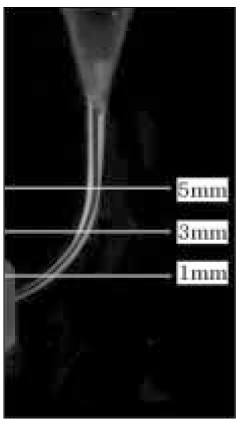Articles
- Page Path
- HOME > Restor Dent Endod > Volume 30(6); 2005 > Article
- Original Article The effect of different flute design and torque-controlled motor on the shaping ability of simulated resin root canals
- Hyoung-Mee Roh, Bock Huh, Hyeon-Cheol Kim, Jeong-Kil Park
-
2005;30(6):-492.
DOI: https://doi.org/10.5395/JKACD.2005.30.6.486
Published online: November 30, 2005
Department of Conservative Dentistry, School of Dentistry, Pusan National University, Korea.
- Corresponding Author: Jeong-Kil Park. Department of Conservative Dentistry, College of Dentistry, Pusan National University, 1-10, Ami-dong, Seo-gu, 602-739, Busan, Korea, 602-739. Tel: 82-51-240-7454, jeongkil@pusan.ac.kr
Copyright © 2005 Korean Academy of Conservative Dentistry
- 626 Views
- 0 Download
Abstract
-
The purpose of this study was to compare the shaping ability of the two different Ni-Ti file systems and the two different engine systems in simulated canals.A total of four groups of each 10 were tested. Each group was instrumented with HeroShaper®and Endo-Mate2® (Group HE), HeroShaper® and Tecnika® (Group HT), ProFile® and Endo-Mate2® (Group PE), and ProFile® and Tecnika® (Group PT).Canal preparation time was recorded. The images of pre- and post-instrumented root canals were scanned and superimposed. The amounts of increased width and centering ratio were measured and calculated at apical 1, 3 and 5 mm levels.These data were statistically analyzed with one-way ANOVA and Duncan's multiple range testThe results of this study were as follows;1. Canal preparation time of HT group was the shortest (p < 0.05).2. The amount of increased canal width in HE group was significantly larger than PT group at apical 1 mm level (p < 0.05). At apical 3 mm level, PT group was significantly smaller than other groups (p < 0.05). At apical 5 mm level, PE group was significantly larger than PT group (p < 0.05).3. The amount of centering ratio in HE group was significantly larger than other groups (p < 0.05). At apical 5 mm level, HT group was significantly larger than PE group and PT group (p < 0.05).Under the condition of this study, torque-controlled endodontic motor is safer than no torque controlled motor, especially when the active file is used.
- 1. Gambarini G. Rationale for the use of low torque endodontic motors in root canal instrumentation. Endod Dent Traumatol. 2000;16: 95-100.ArticlePubMedPDF
- 2. Morgan LF, Montgomery S. An evaluation of the crown-down pressureless technique. J Endod. 1984;10: 491-498.ArticlePubMed
- 3. Davis RD, Marshall JG, Baumgartner JC. Effect of early coronal flaring on working length change in curved canals using rotary nickel-titanium versus stainless steel instruments. J Endod. 2002;28: 438-442.ArticlePubMed
- 4. Sattapan B, Nervo GJ, Palamara JE, Messer HH. Defects in rotary nickel-titanium files after clinical use. J Endod. 2000;26: 161-165.ArticlePubMed
- 5. Suffridge CB, Hartwell GR, Walker TL. Cleaning efficiency of Nickel-Titanium GT and .04 Rotary Files when used in a torque-controlled rotary handpiece. J Endod. 2003;29: 346-348.ArticlePubMed
- 6. Haikel Y, Gasser P, Allemann C. Dynamic fracture of hybrid endodontic hand instruments compared with traditional files. J Endod. 1991;17: 217-220.PubMed
- 7. Wildey WL, Senia ES, Montgomery S. Another look at root canal instrumentation. Oral Surg Oral Med Oral Pathol. 1992;74: 499-507.ArticlePubMed
- 8. Bahcall JK, Barss JT. Understanding and evaluating the endodontic file. Gen Dent. 2000;48: 690-692.PubMed
- 9. Averbach RE, Kleier DJ. Endodontics in the 21st century: the rotary revolution. Compend Contin Educ Dent. 2001;22: 27-34.
- 10. Camps JJ, Pertot WJ. Torsional and stiffness properties of nickel-titanium K files. Int Endod J. 1995;28: 239-243.ArticlePubMed
- 11. Schneider SW. A comparison of canal preperations in straight and curved root canals. Oral Surg Oral Med Oral Pathol. 1971;32: 271-275.PubMed
- 12. Kuhn WG, Carnes DL Jr, Clement DJ, Walker WA 3rd. Effect of tip design of nickel-titanium and stainless steel files on root canal preperation. J Endod. 1997;23: 735-738.PubMed
- 13. Calhoun G, Montgomery S. The effects of four instrumentation techniques on root canal shape. J Endod. 1988;14: 273-277.ArticlePubMed
- 14. Kosa DA, Marshall G, Baumgartner JC. An analysis of canal centering using mechanical instrumentation techniques. J Endod. 1999;25: 441-445.ArticlePubMed
- 15. Buchanan LS. The standardized-taper root canal preperation-Part 1. Concepts for variably tapered shaping instruments. Int Endod J. 2000;33: 516-529.PubMed
- 16. Coleman Cl, Svec TA. Analysis of Ni-Ti versus stainless steel instrumentation in resin simulated canals. J Endod. 1997;23: 232-235.ArticlePubMed
- 17. Blum JY, Machtou P, Micallef JP. Location of contact areas on rotary Profile instruments in relationship to the forces developed during mechanical preperation on extracted teeth. Int Endod J. 1999;32: 108-114.PubMed
- 18. Yared G, Kulkarni GK. Accuracy of the DTC torque control motor for nickel-titanium rotary instruments. Int Endod J. 2004;37: 399-402.ArticlePubMed
- 19. Glossen CR, Haller RH, Dove SB, del Rio CE. A comparision of root canal preperation using Ni-Ti hand, Ni-Ti engine-driven, and K-Flex endodontic instruments. J Endod. 1995;21: 146-151.PubMed
REFERENCES

Tables & Figures
REFERENCES
Citations



Figure 1
Figure 2
Classification of groups
Preparation sequence
Preparation time (seconds)
ANOVA analysis, significantly different at p < 0.05.
Increased canal width (Mean ± S.D., µm)
ANOVA analysis, significantly different at p < 0.05.
a, b, c: For between-group comparisons among vertically aligned rows, VALUES that are not significantly different are annotated with the same letter.
Centering ratio of each group (Mean ± S.D., %)
ANOVA analysis, significantly different at p < 0.05.
a, b, c: For between-group comparisons among vertically aligned rows, VALUES that are not significantly different are annotated with the same letter.
ANOVA analysis, significantly different at p < 0.05.
ANOVA analysis, significantly different at p < 0.05. a, b, c: For between-group comparisons among vertically aligned rows, VALUES that are not significantly different are annotated with the same letter.
ANOVA analysis, significantly different at p < 0.05. a, b, c: For between-group comparisons among vertically aligned rows, VALUES that are not significantly different are annotated with the same letter.

 KACD
KACD






 ePub Link
ePub Link Cite
Cite

